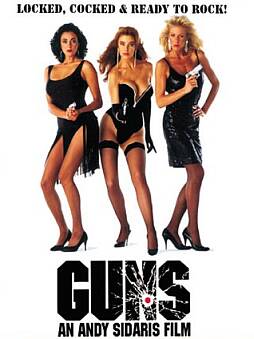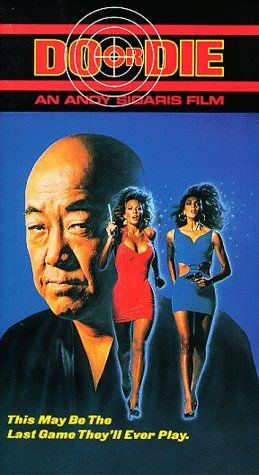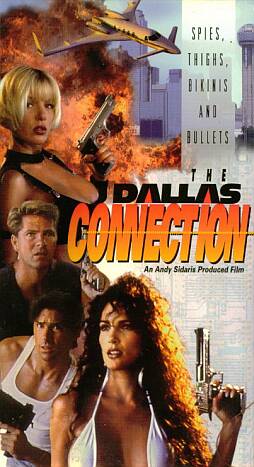 Interestingly, in the past year, all three of the computer-game to movie adaptations have had heroines: Lara Croft, Aki (Final Fantasy), and now, Resident Evil‘s Alice, who wakes up one day with a splitting headache and no memory. I’ve had mornings like that too. However, I never found myself kidnapped by a SWAT team and dragged into the Hive, an underground complex populated by the walking dead (human and canine), a peeved computer, and a mutated computer graphic monster called the Licker. My stepson somewhat gleefully informed me that, in the game, the last-named’s method of attack is to wrap its tongue round your head and pull it off. The movie doesn’t go so far – it just kinda nibbles on its victims. I felt somewhat disappointed at this display of taste and restraint, not least because it ran contrary to much of the rest of the movie. This is not a subtle movie, relying heavily on things leaping in from outside the frame, while the soundtrack goes “Boo!”.
Interestingly, in the past year, all three of the computer-game to movie adaptations have had heroines: Lara Croft, Aki (Final Fantasy), and now, Resident Evil‘s Alice, who wakes up one day with a splitting headache and no memory. I’ve had mornings like that too. However, I never found myself kidnapped by a SWAT team and dragged into the Hive, an underground complex populated by the walking dead (human and canine), a peeved computer, and a mutated computer graphic monster called the Licker. My stepson somewhat gleefully informed me that, in the game, the last-named’s method of attack is to wrap its tongue round your head and pull it off. The movie doesn’t go so far – it just kinda nibbles on its victims. I felt somewhat disappointed at this display of taste and restraint, not least because it ran contrary to much of the rest of the movie. This is not a subtle movie, relying heavily on things leaping in from outside the frame, while the soundtrack goes “Boo!”.
Of course, that doesn’t make it a bad movie. Nor do the obvious plot-holes. Here are a few examples:
- Why would an assault team choose to take a pair of amnesiac security guards on the mission with them?
- Zombie humans shamble along at classic Romero speed. Zombie dogs can run like greyhounds.
- Security lasers in a corridor zip along with a variety of heights/patters, before finally switching to an inescapable grid-pattern. Why didn’t they do that to start with?
These are forgivable – the first is necessary to the plot, and Anderson (a veteran of game/movies, having done Mortal Kombat) uses the other flaws to stage satisfyingly cool sequences, with the security lasers perhaps the highpoint of the film. It’s a shame this represents about the extent of the Hive’s defenses; I’d have liked to have seen more ingenuity of this sort. The rest of the story revolves around the T-virus, being developed by the corporation that runs the Hive – when the virus is stolen and released, the Hive goes into lock-down, with the central computer (the Red Queen, personified by a little girl hologram with a nice line in not-so-idle threats) killing all the personnel inside. Bad move, for the T-virus reanimates them, turning them into hungry cannibals, which adds an extra frisson to the assault team’s mission.
 This is to…er, well, I think it was to disarm the computer, but I’m not certain about that. Mind you, I’m not certain about quite a lot in this movie. The characterisation is so woeful, I managed to combine two opposing characters into one for the entire film. And it still made sense – indeed, even after Chris enlightened me, I felt my version was better. My version would also have discarded the clock countdown, or used it as the basis for an exciting race against time through the tunnels. What’s the point of a countdown, if you don’t see it in the last ten minutes? There’s also maddeningly shallow nods to Lewis Carroll: the heroine is called Alice, who goes down a “rabbit hole”, while the computer is the Red Queen with a fondness for lopping off peoples’ heads. You should either do this stuff to the hilt, or not at all.
This is to…er, well, I think it was to disarm the computer, but I’m not certain about that. Mind you, I’m not certain about quite a lot in this movie. The characterisation is so woeful, I managed to combine two opposing characters into one for the entire film. And it still made sense – indeed, even after Chris enlightened me, I felt my version was better. My version would also have discarded the clock countdown, or used it as the basis for an exciting race against time through the tunnels. What’s the point of a countdown, if you don’t see it in the last ten minutes? There’s also maddeningly shallow nods to Lewis Carroll: the heroine is called Alice, who goes down a “rabbit hole”, while the computer is the Red Queen with a fondness for lopping off peoples’ heads. You should either do this stuff to the hilt, or not at all.
On the plus side, we do have Milla Jovovich as Alice, and Michelle Rodriguez as the Vasquezesque Rain, who are about the only easily identifiable characters. The former drives the plot along as her memory slowly returns at convenient intervals, along with her ability to kick butt. Most notable is the kung-fu vs. zombie Dobermann battle seen in the trailer, though she does the same neck-snap with the thighs thing that Famke Janssen did in Goldeneye. It’s a further step on for Jovovich, who showed action potential in The Fifth Element, yet there isn’t enough here to truly satisfy. Rodriguez, too, is underused, marching through her third straight film (Girlfight, Fast and the Furious) with the same expression. I thought I saw her smile once, near the start, but it was probably a digital effect added in post-production.
So, not as good as it could have been, with even the most undemanding viewer able to imagine improvements. Yet, as an action/SF/horror film goes, it’s not bad at all, with very little slack or let-up. The virus is released in the first two minutes, and it’s pretty much non-stop from there on, with plenty going on. Jovovich looks the part, and the final shot has me anticipating the sequel, in a kind of Evil Dead 2 way, with her character getting totally medieval on the zombies’ asses. We can but hope.
Dir: Paul W.S. Anderson
Star: Milla Jovovich, Michelle Rodriguez, Eric Mabius, James Purefoy






 Also known as Hard Titties in Hawaii – at least in this house – it’s a big step forward as far as the evolution of Sidaris’ work goes. After the flailing around that was Malibu Express, he’s now firmly settled on Hawaii as a location, and jiggly action/adventure as the genre. However, he still unfortunately seems to want to cram lame comedy in there, such as clunky references to his previous films, while many of the actors appear not to have been chosen for their thespian ability – to their credit, Speir and Carlton aren’t particularly the worst offenders.
Also known as Hard Titties in Hawaii – at least in this house – it’s a big step forward as far as the evolution of Sidaris’ work goes. After the flailing around that was Malibu Express, he’s now firmly settled on Hawaii as a location, and jiggly action/adventure as the genre. However, he still unfortunately seems to want to cram lame comedy in there, such as clunky references to his previous films, while many of the actors appear not to have been chosen for their thespian ability – to their credit, Speir and Carlton aren’t particularly the worst offenders. Female action fans would be well advised to give this a wide berth. Actually, so should everyone else, unless they’re fans of crass sexism, extremely clunky exposition and hideous country & western. Cody Abilene (Hinton) is a PI hired by Countess Luciana (Danning) to look into the export of illegal computer technology to the Russians, centred on the home of Lady Lillian Chamberlain. Who is responsible? Oversexed chauffeur Shane? Daughters Lisa and Anita? Or the maid, Marion? [groan…]
Female action fans would be well advised to give this a wide berth. Actually, so should everyone else, unless they’re fans of crass sexism, extremely clunky exposition and hideous country & western. Cody Abilene (Hinton) is a PI hired by Countess Luciana (Danning) to look into the export of illegal computer technology to the Russians, centred on the home of Lady Lillian Chamberlain. Who is responsible? Oversexed chauffeur Shane? Daughters Lisa and Anita? Or the maid, Marion? [groan…] While this wasn’t Sidaris’s first feature – he’d done The Racing Scene, with James Garner in 1967 – this was likely the prototype of the BB&B (Blood, Bullets & Babes) flicks that would become his trademark. If all the elements do not quite mesh in the way they eventually would, they are all present, mostly in the shape of Anne Randall, a former Playboy playmate who plays private investigator Stacey, and looks a bit like Heather Graham.
While this wasn’t Sidaris’s first feature – he’d done The Racing Scene, with James Garner in 1967 – this was likely the prototype of the BB&B (Blood, Bullets & Babes) flicks that would become his trademark. If all the elements do not quite mesh in the way they eventually would, they are all present, mostly in the shape of Anne Randall, a former Playboy playmate who plays private investigator Stacey, and looks a bit like Heather Graham. The above quote, from one essay in this collection of pieces on “violent women in the movies”, perhaps sums up its main problem. I cheerfully admit that my writing is skewed heavily towards the former point of view, but even so, too many of the authors here seem concerned with squeezing meanings out of films that were never intended to be there. This over-analytical approach results in the book swinging between thought-provoking and infuriating on almost every page.
The above quote, from one essay in this collection of pieces on “violent women in the movies”, perhaps sums up its main problem. I cheerfully admit that my writing is skewed heavily towards the former point of view, but even so, too many of the authors here seem concerned with squeezing meanings out of films that were never intended to be there. This over-analytical approach results in the book swinging between thought-provoking and infuriating on almost every page.
 Part three is a return to form, despite a title which might now seem suspiciously unoriginal, at first glance on the video shelves. But it actually predates James Cameron’s series, leaving his genetically-altered, motorcycle-riding loner firmly in the position of late-comer. The mathematics for this one are harder to define, since the ideas on view are…well, if in light of the first two movies, I’m reluctant to claim originality, they are at least taken from less obvious sources. There is thus an “X” factor to take in account here, where X may or may not be genuine inventiveness.
Part three is a return to form, despite a title which might now seem suspiciously unoriginal, at first glance on the video shelves. But it actually predates James Cameron’s series, leaving his genetically-altered, motorcycle-riding loner firmly in the position of late-comer. The mathematics for this one are harder to define, since the ideas on view are…well, if in light of the first two movies, I’m reluctant to claim originality, they are at least taken from less obvious sources. There is thus an “X” factor to take in account here, where X may or may not be genuine inventiveness. I imagine no-one genuinely doubts the answer, but this adds a whole new plot twist, especially as the last time the Mongoose activated his weapon, its impact was pretty heavy. What happens when it’s used here is never really shown, and there is some scientific handwaving about the black hole absorbing all the energy, but it would be gratifying to think that it became necessary to destroy the city in order to save it. Not least because Cameron’s Dark Angel
I imagine no-one genuinely doubts the answer, but this adds a whole new plot twist, especially as the last time the Mongoose activated his weapon, its impact was pretty heavy. What happens when it’s used here is never really shown, and there is some scientific handwaving about the black hole absorbing all the energy, but it would be gratifying to think that it became necessary to destroy the city in order to save it. Not least because Cameron’s Dark Angel  Scorpion’s Revenge is an understandable, if not really helpful, retitling of a film called Sasori in USA; as this suggests, it attempts to add an exotic flavour by setting things in an uncivilised and/or dangerous locale. Foreigners are, after all, inherently evil, and do far worse things to our women than we ever would. This isn’t new: many of Roger Corman’s 1970’s WiP movies were shot in the Philippines, albeit partly for cost reasons.
Scorpion’s Revenge is an understandable, if not really helpful, retitling of a film called Sasori in USA; as this suggests, it attempts to add an exotic flavour by setting things in an uncivilised and/or dangerous locale. Foreigners are, after all, inherently evil, and do far worse things to our women than we ever would. This isn’t new: many of Roger Corman’s 1970’s WiP movies were shot in the Philippines, albeit partly for cost reasons.
 It’s perhaps no surprise that Sidaris gravitated towards the action genre, having for many years been a TV sports producer, winning seven Emmys in the process. He also was responsible for the football scenes in M.A.S.H., though director Robertn Altman stiffed him out of credit for that, to Sidaris’s lasting disdain; more than 30 years later,
It’s perhaps no surprise that Sidaris gravitated towards the action genre, having for many years been a TV sports producer, winning seven Emmys in the process. He also was responsible for the football scenes in M.A.S.H., though director Robertn Altman stiffed him out of credit for that, to Sidaris’s lasting disdain; more than 30 years later,  Salazar (Aprea) is a famously devious assassin who gets shot by a sniper just after he donates a painting (of the emblematic ‘Picasso triggerfish’) to a Parisian art gallery. This sparks a series of lethal attacks on undercover federal spy teams who are Salazar’s enemies. But are the various bad-guys, who use all manner of tricks to eliminate government agents, all working for a criminal mastermind?
Salazar (Aprea) is a famously devious assassin who gets shot by a sniper just after he donates a painting (of the emblematic ‘Picasso triggerfish’) to a Parisian art gallery. This sparks a series of lethal attacks on undercover federal spy teams who are Salazar’s enemies. But are the various bad-guys, who use all manner of tricks to eliminate government agents, all working for a criminal mastermind? This one doesn’t really get going until the second half, when the search for a lost hoard of Japanese wartime gold, looted from the Philippines, leads to a remote island. There are CIA agents, revolutionaries, a left-behind Japanese soldier and, of course, our lovely heroines Dona and Taryn (Speir and Carlton) who end up there after their plane crashes in a storm. Or rather, “storm” – you can get a cheap laugh by seeing the bright blue skies as they land in the middle of a clearly hose-supplied downpour. Sidaris probably felt the need to justify their otherwise implausible strip-tease shortly after departure. Or do FAA regulation stipulate pilots must remove their tops in emergencies? Two take-offs for the price of one…
This one doesn’t really get going until the second half, when the search for a lost hoard of Japanese wartime gold, looted from the Philippines, leads to a remote island. There are CIA agents, revolutionaries, a left-behind Japanese soldier and, of course, our lovely heroines Dona and Taryn (Speir and Carlton) who end up there after their plane crashes in a storm. Or rather, “storm” – you can get a cheap laugh by seeing the bright blue skies as they land in the middle of a clearly hose-supplied downpour. Sidaris probably felt the need to justify their otherwise implausible strip-tease shortly after departure. Or do FAA regulation stipulate pilots must remove their tops in emergencies? Two take-offs for the price of one… Two federal agents (Speir and Vasquez) are hot on the trail of South American gangster Degas (Estrada), after one of their friends is shot during one of his hits – but perhaps that’s really what he wants? Zipping around from Hawaii to Arizona to Las Vegas, this was the first Sidaris movie I saw, and was probably better than I expected. While obviously not shot on an unlimited budget, most of the deficiencies are made up for in energy and a host of interesting characters.
Two federal agents (Speir and Vasquez) are hot on the trail of South American gangster Degas (Estrada), after one of their friends is shot during one of his hits – but perhaps that’s really what he wants? Zipping around from Hawaii to Arizona to Las Vegas, this was the first Sidaris movie I saw, and was probably better than I expected. While obviously not shot on an unlimited budget, most of the deficiencies are made up for in energy and a host of interesting characters. In a filmography not exactly noted for thought-out plots, this maybe counts as one of the thinnest. Donna (Speir) and Nicole (Vasquez) are targeted by death for Kane (Morita) for their interference in his illegal business ventures. But rather than simply bumping them off, as any sane criminal mastermind would do, he informs them of his intentions to send six separate pairs of assassins after them, beginning the next morning. Our pair of federal lovelies head out of Hawaii, little knowing that a tracker has been placed on them, allowing Kane’s to follow them, while their master sits in his apartment and follows the progress of his “game” on a computer display resembling a bad TRS-80 game [younger readers can Google “TRS-80” if they need specifics], as they proceed from Las Vegas to Louisiana, with a motley crew of associated agents in tow, including infamous Meyer model, Pandora Peaks. No prizes for guessing her role.
In a filmography not exactly noted for thought-out plots, this maybe counts as one of the thinnest. Donna (Speir) and Nicole (Vasquez) are targeted by death for Kane (Morita) for their interference in his illegal business ventures. But rather than simply bumping them off, as any sane criminal mastermind would do, he informs them of his intentions to send six separate pairs of assassins after them, beginning the next morning. Our pair of federal lovelies head out of Hawaii, little knowing that a tracker has been placed on them, allowing Kane’s to follow them, while their master sits in his apartment and follows the progress of his “game” on a computer display resembling a bad TRS-80 game [younger readers can Google “TRS-80” if they need specifics], as they proceed from Las Vegas to Louisiana, with a motley crew of associated agents in tow, including infamous Meyer model, Pandora Peaks. No prizes for guessing her role. It’s very easy to mock a film, when the lesbian necking starts before the meaningful dialogue, and is immediately followed by a musical number where Cynthia Brimhall channels the spirit of Jimmy Buffett. Yet the endearing loopiness on display here did a better job of keeping my interest throughout than many movies made with far larger budgets. The plot centers on a jade Buddha, containing a nuclear trigger, which starts off in the hands of Kane (Moore), only for it to be swiped by an undercover agent: she is gunned down, but passes it to Donna (Speir), who has to try and keep it out of Kane’s clutches. However, an unfortunate bout of amnesia leaves her partner Nicole (Vazquez) and the other agents trying to find her first.
It’s very easy to mock a film, when the lesbian necking starts before the meaningful dialogue, and is immediately followed by a musical number where Cynthia Brimhall channels the spirit of Jimmy Buffett. Yet the endearing loopiness on display here did a better job of keeping my interest throughout than many movies made with far larger budgets. The plot centers on a jade Buddha, containing a nuclear trigger, which starts off in the hands of Kane (Moore), only for it to be swiped by an undercover agent: she is gunned down, but passes it to Donna (Speir), who has to try and keep it out of Kane’s clutches. However, an unfortunate bout of amnesia leaves her partner Nicole (Vazquez) and the other agents trying to find her first. Hang on, two movies ago, criminal mastermind Kane was Japanese – now, he’s the son of a Nazi officer who went on the run after the war with a diamond stolen from the Russians? I know I’m watching these all of our order, but still… They even refer to a pendant with a tracking device in it, given to the Japanese version of Kane, even though Moore now appears to be channeling Julian Sands, not Pat Morita. I’m so confused. Still, logic, continuity and coherence are not really the point here, are they?
Hang on, two movies ago, criminal mastermind Kane was Japanese – now, he’s the son of a Nazi officer who went on the run after the war with a diamond stolen from the Russians? I know I’m watching these all of our order, but still… They even refer to a pendant with a tracking device in it, given to the Japanese version of Kane, even though Moore now appears to be channeling Julian Sands, not Pat Morita. I’m so confused. Still, logic, continuity and coherence are not really the point here, are they? While containing many of the same elements as usual e.g. boobs and bombs, this does at least throw in a new angle, in the shape of some Confederate gold buried in the woods since the Civil War – I can only presume Sidaris must have befriended a Civil War re-enactment battalion. Out enjoying a bit of off-road action, amusingly-named federal agent Becky Midnite (Simpson) and her two co-workers stumble across a diary written by one of the soldiers transporting the gold. However, their plans to search for the treasure are disrupted by efforts to kill them, courtesy of mob boss Santiago. He is upset after they shut down his operation that involved shipping drugs in hollowed-out watermelons. Fed up with the ineptness of his minions, he hires even more amusingly-named assassin Jewel Panther (Strain) to carry out what they have failed to do.
While containing many of the same elements as usual e.g. boobs and bombs, this does at least throw in a new angle, in the shape of some Confederate gold buried in the woods since the Civil War – I can only presume Sidaris must have befriended a Civil War re-enactment battalion. Out enjoying a bit of off-road action, amusingly-named federal agent Becky Midnite (Simpson) and her two co-workers stumble across a diary written by one of the soldiers transporting the gold. However, their plans to search for the treasure are disrupted by efforts to kill them, courtesy of mob boss Santiago. He is upset after they shut down his operation that involved shipping drugs in hollowed-out watermelons. Fed up with the ineptness of his minions, he hires even more amusingly-named assassin Jewel Panther (Strain) to carry out what they have failed to do. Among Sidaris fans, I imagine arguments over whether this one counts, much like the Never Say Never Again debate among 007 lovers. For this was directed not by Andy, but son Drew; Dad and Mom were merely executive producers. However, the content is much the same, though (and I can’t believe I’m writing this) Drew lacks the subtle touch of Sidaris Sr. Case in point: the very first shot is of the Eiffel Tower, establishing that this is Paris. However, the point is then rammed home with footage of the Arc De Triomphe, Place de la Concorde and Notre Dame. Similarly before the ‘South African’ scenes; we get so much wildlife footage, it feels more like the Discovery Channel.
Among Sidaris fans, I imagine arguments over whether this one counts, much like the Never Say Never Again debate among 007 lovers. For this was directed not by Andy, but son Drew; Dad and Mom were merely executive producers. However, the content is much the same, though (and I can’t believe I’m writing this) Drew lacks the subtle touch of Sidaris Sr. Case in point: the very first shot is of the Eiffel Tower, establishing that this is Paris. However, the point is then rammed home with footage of the Arc De Triomphe, Place de la Concorde and Notre Dame. Similarly before the ‘South African’ scenes; we get so much wildlife footage, it feels more like the Discovery Channel. Andy was back on the helm for this one, but appears to have opted to go beyond subtle self-referential digs into full-blown camp, and I tend to think this takes away from the overall experience. The intent is clear when we are brought into the office of Willow Black, the head of L.E.T.H.A.L. (The Legion to Ensure Total Harmony and Law), and find her exercising on a treadmill in an outfit more suited for an exotic dancer. Which makes sense, because if you’re a female agent of LETHAL, you can bet you’ll be going undercover as a stripper or a porn actress – not quite the empowering government job one might expect. It also appears that breast enlargement surgery is required for all such operatives.
Andy was back on the helm for this one, but appears to have opted to go beyond subtle self-referential digs into full-blown camp, and I tend to think this takes away from the overall experience. The intent is clear when we are brought into the office of Willow Black, the head of L.E.T.H.A.L. (The Legion to Ensure Total Harmony and Law), and find her exercising on a treadmill in an outfit more suited for an exotic dancer. Which makes sense, because if you’re a female agent of LETHAL, you can bet you’ll be going undercover as a stripper or a porn actress – not quite the empowering government job one might expect. It also appears that breast enlargement surgery is required for all such operatives. This was Sidaris’s last film, and after the disappointment of Warrior, it’s nice to see him return to a more straightforward approach, with little of the post-modernity attempted there. It is largely a sequel to Savage Beach, with a raid on the LETHAL offices puzzling Willow (Strain) and her agents, because the only thing accessed was the files on that case, which have long been closed. However, it turns out the villain there, Rodrigo (Obregon) did not die in a fiery, explosive-tipped crossbow bolt explosion as thought, and now sports a nifty mask, apparently lifted from a production of Phantom of the Opera. He sends his blonde minion in her submarine(!), along with his ninjas(!!), back to the island to claim a priceless Golden Buddha buried there, and it’s up to Cobra (Smith), Tiger (Marks) and their himbo colleagues, to stop him.
This was Sidaris’s last film, and after the disappointment of Warrior, it’s nice to see him return to a more straightforward approach, with little of the post-modernity attempted there. It is largely a sequel to Savage Beach, with a raid on the LETHAL offices puzzling Willow (Strain) and her agents, because the only thing accessed was the files on that case, which have long been closed. However, it turns out the villain there, Rodrigo (Obregon) did not die in a fiery, explosive-tipped crossbow bolt explosion as thought, and now sports a nifty mask, apparently lifted from a production of Phantom of the Opera. He sends his blonde minion in her submarine(!), along with his ninjas(!!), back to the island to claim a priceless Golden Buddha buried there, and it’s up to Cobra (Smith), Tiger (Marks) and their himbo colleagues, to stop him. ★★★★★
★★★★★ For in many ways, this is a Vietnam allegory. A technologically superior, arrogant military force lands in foreign territory…and gets its butt kicked by a ferocious enemy with no moral qualms, while the non-combatants are happy to plot their demise in pursuit of some other cause. It is likely also significant that Cameron worked on First Blood, Part II, which is perhaps why some reviewers e.g. the Philadelphia Daily News, referred to Aliens as “Rambo in space”.
For in many ways, this is a Vietnam allegory. A technologically superior, arrogant military force lands in foreign territory…and gets its butt kicked by a ferocious enemy with no moral qualms, while the non-combatants are happy to plot their demise in pursuit of some other cause. It is likely also significant that Cameron worked on First Blood, Part II, which is perhaps why some reviewers e.g. the Philadelphia Daily News, referred to Aliens as “Rambo in space”.
